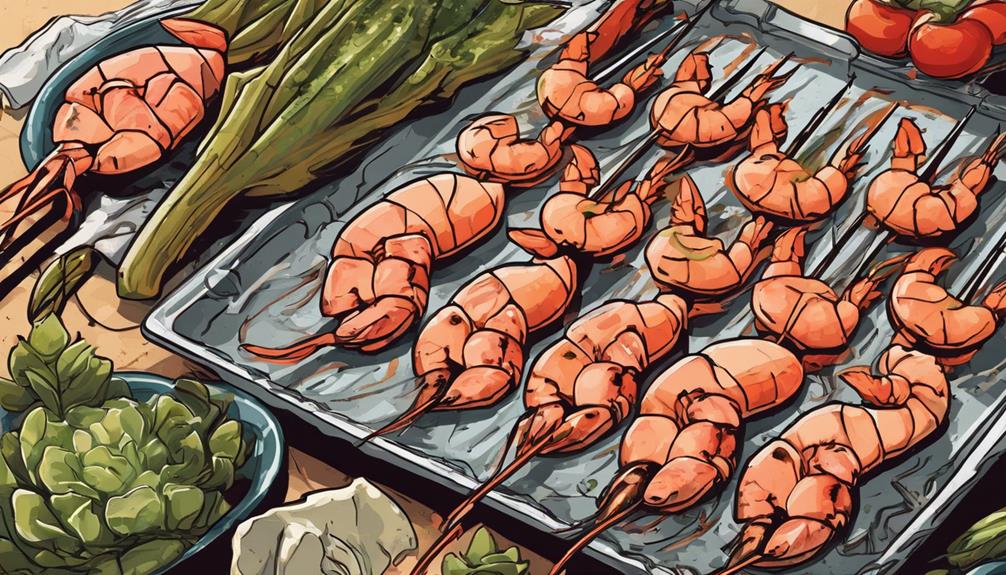When it comes to cooking shrimp, the choice between grilling, baking, or sautéing depends on your taste preferences. Grilling gives a smoky flavor and lovely grill marks but may overcook quickly; baking is convenient and retains natural flavors but lacks charred taste; sautéing is quick and customizable but could lead to overcooked shrimp. Each method offers distinct flavors and textures, so consider what you enjoy most. Explore further to uncover more tips for your perfect shrimp dish.
Main Points
- Grilling offers smoky flavor and beautiful grill marks.
- Baking is convenient with minimal oil and easy seasoning.
- Sautéing is quick, customizable, and retains natural flavors.
- Consider health benefits and unique flavor profiles of each method.
- Choose based on desired texture, cooking time, and equipment available.
Grilling Shrimp Pros and Cons
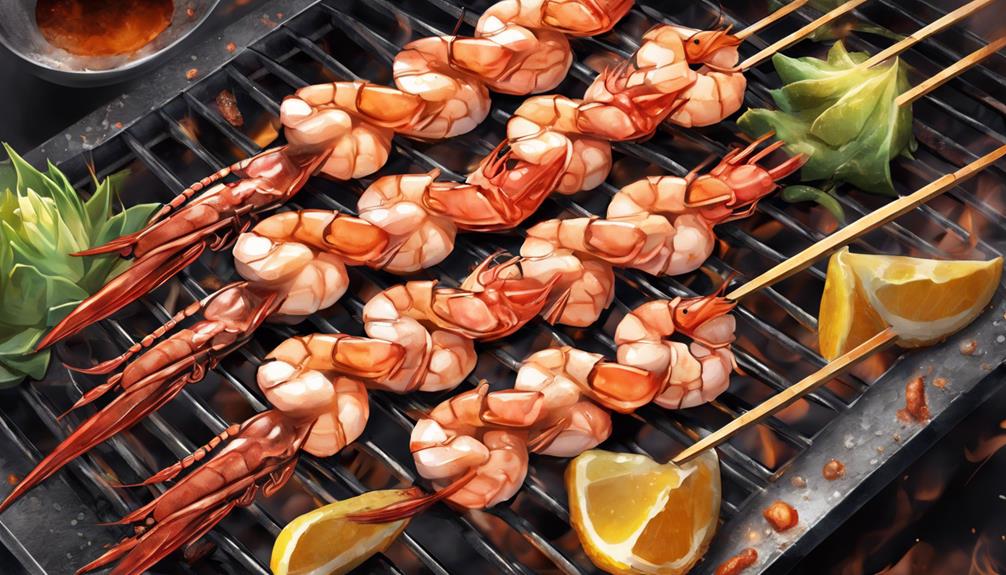
Grilling shrimp can be a quick and flavorful way to cook this popular seafood, but it also comes with its own set of advantages and disadvantages.
One major advantage of grilling shrimp is the smoky flavor it imparts, enhancing the natural sweetness of the shrimp. The important cooking time on a hot grill helps to seal in the juices, keeping the shrimp tender and juicy. Additionally, grilling allows for beautiful grill marks, adding to the presentation of the dish.
On the flip side, one drawback of grilling shrimp is the risk of overcooking. Shrimp cook very quickly, so it's essential to pay close attention to prevent them from becoming rubbery. Another disadvantage is that smaller shrimp can fall through the grill grates if not properly secured. Despite these challenges, with proper preparation and monitoring, grilling shrimp can result in a delicious and visually appealing dish that's perfect for a summer barbecue or a quick weeknight meal.
Baking Shrimp Pros and Cons
Now shifting our focus to baking shrimp, let's explore the pros and cons of this cooking method.
Baking shrimp is a convenient way to cook this seafood delicacy without needing constant attention. One major advantage is that baking helps retain the natural flavors of the shrimp while enhancing them with the chosen seasonings. It also requires minimal oil, making it a vital option compared to frying. Additionally, baking allows for easy preparation by simply seasoning the shrimp, placing them on a baking sheet, and letting the oven do the work.
However, there are some drawbacks to baking shrimp. One of the main cons is that shrimp can easily overcook in the oven, resulting in a rubbery texture. To prevent this, it's essential to monitor the cooking time closely. Another limitation is that baking may not provide the same level of caramelization or charred flavor that grilling or sautéing can achieve.
Sautéing Shrimp Pros and Cons
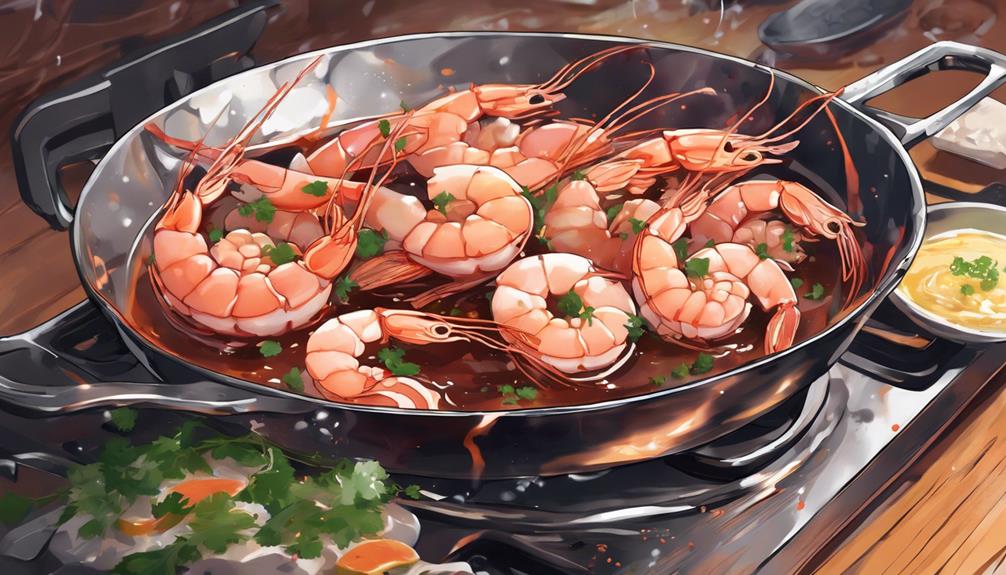
When sautéing shrimp, the quick cooking method offers both advantages and disadvantages to take into account. Sautéing shrimp is a popular cooking technique that can result in delicious dishes, but it also has its drawbacks. Here are some pros and cons to ponder:
Pros:
- Quick cooking time, perfect for busy weeknights.
- Retains the natural flavors and juices of the shrimp.
- Easy to customize with different seasonings and sauces.
- Creates a nice caramelized exterior for added flavor.
- Allows for easy monitoring of doneness to prevent overcooking.
Cons:
- Requires constant attention and stirring to prevent sticking or burning.
- Can result in uneven cooking if shrimp aren't similar in size.
- May not develop the same smoky or charred flavors as grilling.
- Limited capacity depending on the size of the pan.
- Can be easy to overcook shrimp if not careful with timing.
Sautéing shrimp can be a versatile and convenient cooking method, but it's essential to weigh these pros and cons to achieve the best results.
Flavor Comparison: Grilling Vs. Baking Vs. Sautéing
Considering the various cooking methods for shrimp, exploring the flavor distinctions between grilling, baking, and sautéing can provide valuable insights into enhancing your culinary creations. Each method offers a unique taste profile that can elevate the shrimp dish you are preparing. Let's break down the flavor characteristics of each cooking technique:
| Cooking Method | Flavor Profile | Key Benefits |
|---|---|---|
| Grilling | Smoky and charred | Infuses a delightful smokiness into the shrimp |
| Baking | Light and delicate | Retains the natural sweetness of the shrimp |
| Sautéing | Rich and savory | Allows for quick cooking with added depth of flavor |
Grilling imparts a smoky and charred essence to the shrimp, adding depth to the overall taste. Baking preserves the shrimp's natural sweetness, creating a light and delicate flavor profile. On the other hand, sautéing provides a rich and savory taste due to quick cooking at high heat. Experimenting with these methods can help you discover which flavor profile best complements your shrimp dishes.
Texture Differences: Grilling Vs. Baking Vs. Sautéing
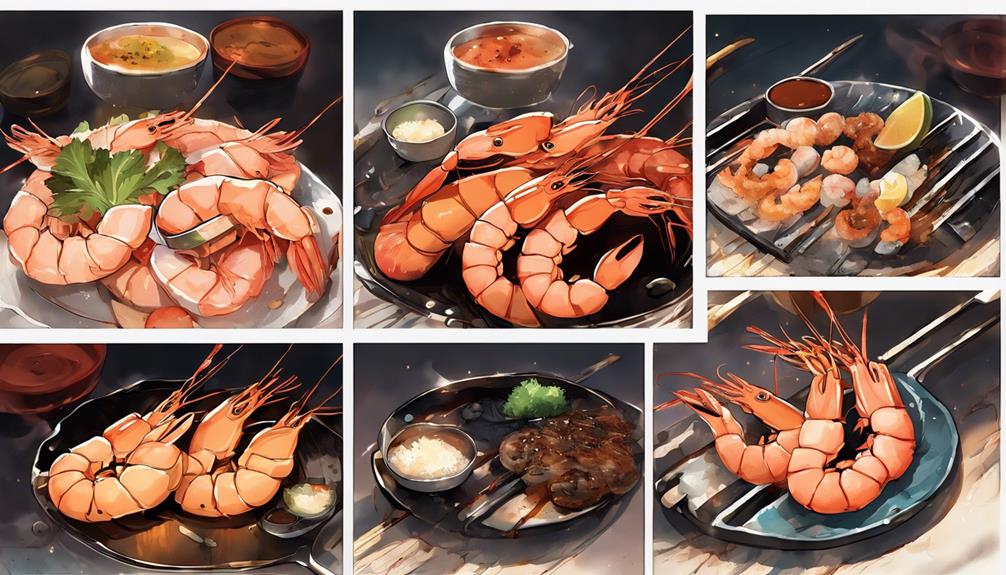
Exploring the cooking methods of grilling, baking, and sautéing shrimp reveals distinct textural variations that can greatly impact the overall dining experience. Each method offers a unique texture profile that caters to different preferences. Here's a breakdown to help you understand the differences: Grilling shrimp imparts a smoky char and a slightly firm texture, making it ideal for bold, savory dishes. Baking, on the other hand, creates a tender and juicy consistency, perfect for dishes where the shrimp absorbs surrounding flavors. If you’re wondering how long to sauté shrimp, it typically takes just 2-3 minutes per side over medium-high heat, resulting in a delicate sear with a subtly crisp exterior.
- Grilling:
- Provides a smoky and slightly charred exterior.
- Offers a firm texture with caramelized edges.
- Baking:
- Results in a more gentle cooking process.
- Yields a tender and moist texture.
- Sautéing:
- Quick cooking method at high heat.
- Creates a slightly crisp exterior while keeping the interior tender.
Health Benefits of Grilling, Baking, and Sautéing Shrimp
Grilling, baking, and sautéing shrimp offer distinct health benefits that cater to varied dietary preferences and nutritional needs. When considering the health aspect of cooking shrimp, it's essential to understand how different cooking methods can impact the nutritional value of this popular seafood. Here's a comparison of the health benefits associated with grilling, baking, and sautéing shrimp:
| Cooking Method | Health Benefits |
|---|---|
| Grilling | – Retains more nutrients |
| – Adds a smoky flavor | |
| – Requires less added fat | |
| Baking | – Preserves moisture in shrimp |
| – Allows for easy seasoning | |
| – Minimal oil needed for cooking | |
| Sautéing | – Quick cooking method |
| – Enhances shrimp with flavors | |
| – Can incorporate various ingredients |
Each cooking method offers its own advantages, allowing you to choose the option that best suits your health goals and taste preferences. Whether you prefer the smoky char of grilled shrimp, the moist tenderness of baked shrimp, or the quick and flavorful sautéed shrimp, you can enjoy a delicious meal while reaping the health benefits of these cooking techniques.
Cooking Time and Convenience Factors
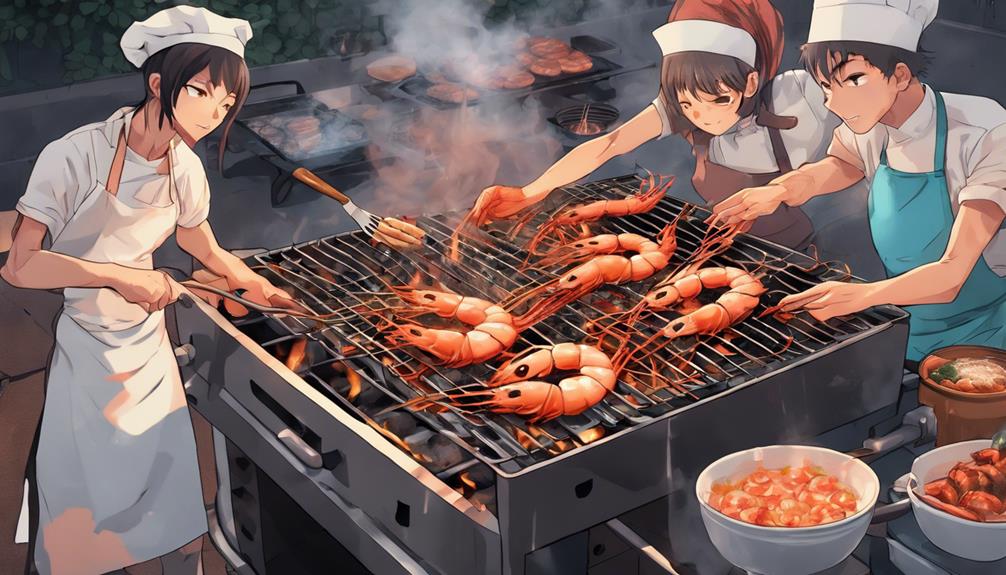
When deciding how to cook shrimp, evaluating the cooking time and convenience factors is essential for a seamless culinary experience. Shrimp cooks relatively quickly, so pondering the time you have available and your convenience preferences can help you choose the best cooking method. Here are some key points to ponder:
- Grilling: Grilling shrimp is quick and imparts a smoky flavor, making it a great option for busy weeknights.
- Baking: Baking shrimp in the oven is hands-off once you pop them in, allowing you to attend to other tasks while they cook.
- Sautéing: Sautéing shrimp on the stovetop is fast and gives you control over the cooking process for precise results.
- Prep Time: Consider the time needed to prepare the shrimp for cooking, such as deveining and peeling, to factor into your overall cooking timeline.
- Cleanup: Think about the cleanup involved with each cooking method to guarantee a stress-free cooking experience.
Equipment and Tools Needed for Each Method
To cook shrimp using different methods, you'll need specific equipment and tools tailored to each technique. For grilling shrimp, essential tools include a grill (gas or charcoal), tongs for flipping, and a brush for applying marinade. Baking shrimp requires an oven, baking sheet, and aluminum foil or parchment paper to prevent sticking. Sautéing shrimp calls for a skillet or sauté pan, a spatula for flipping, and potentially a lid for certain recipes that require steaming.
Grilling shrimp provides a smoky flavor and beautiful grill marks but demands outdoor space and careful monitoring to prevent overcooking. Baking shrimp is convenient and allows for easy cleanup but may lack the charred taste of grilling. Sautéing shrimp is quick and ideal for stovetop cooking, offering versatility in adding various seasonings and sauces.
Each method has its advantages, so choose based on your preference for flavors and convenience. Having the appropriate equipment for grilling, baking, or sautéing shrimp ensures a successful cooking experience tailored to your taste preferences.
Tips for Perfectly Grilled, Baked, or Sautéed Shrimp
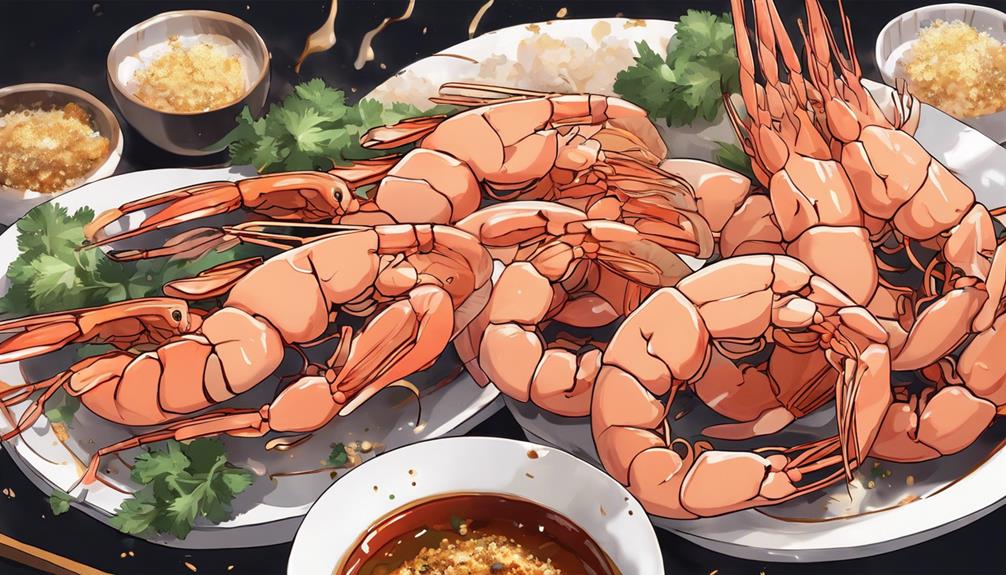
For perfectly grilled, baked, or sautéed shrimp, mastering a few key techniques can elevate your shrimp dishes to a new level of flavor and texture. Here are some tips to help you achieve perfectly cooked shrimp every time:
- Don't Overcook: Shrimp cooks quickly, so be cautious not to overcook them to avoid a rubbery texture.
- Proper Seasoning: Season your shrimp well before cooking to guarantee they're flavorful throughout.
- Preheat the Pan or Grill: Make sure your pan or grill is preheated before adding the shrimp to secure a nice sear and prevent sticking.
- Use High Heat: Whether grilling, baking, or sautéing, using high heat helps to cook the shrimp quickly and maintain their tenderness.
- Monitor Closely: Keep a close eye on your shrimp while cooking to prevent them from becoming tough or dry.
Conclusion
To sum up, whether you opt to grill, bake, or sauté shrimp, each method has its own unique pros and cons. Grilling offers a smoky flavor, baking results in a tender texture, and sautéing provides a quick and easy option.
Consider the flavor, texture, health benefits, and cooking time when deciding which method to use. Whichever method you choose, follow our tips for perfectly cooked shrimp every time. Experiment and enjoy the delicious results!
